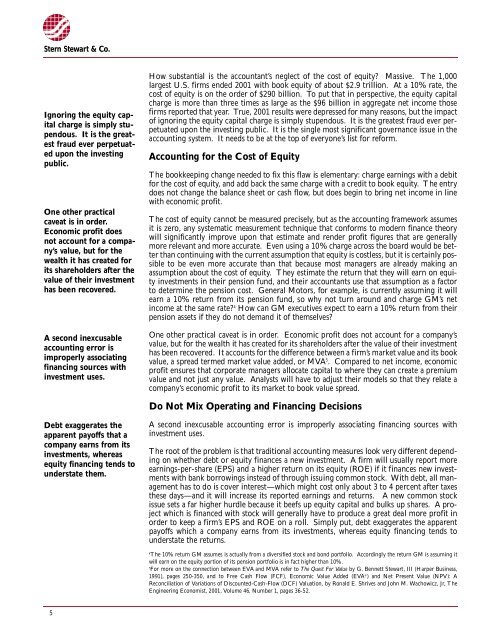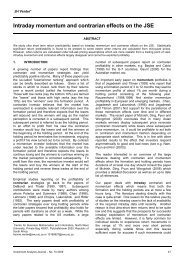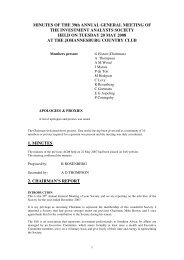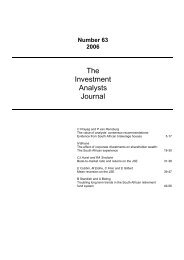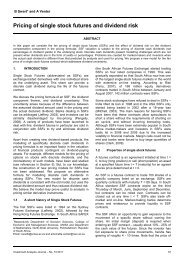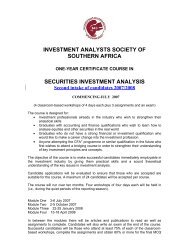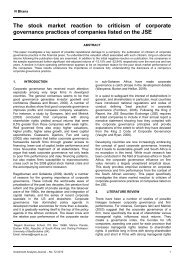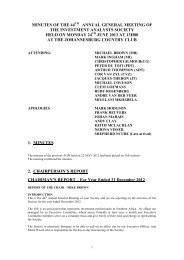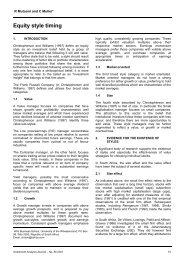Accounting is Broken - Investment Analysts Journal
Accounting is Broken - Investment Analysts Journal
Accounting is Broken - Investment Analysts Journal
Create successful ePaper yourself
Turn your PDF publications into a flip-book with our unique Google optimized e-Paper software.
Stern Stewart & Co.<br />
Ignoring the equity capital<br />
charge <strong>is</strong> simply stupendous.<br />
It <strong>is</strong> the gre a t-<br />
est fraud ever perpetuated<br />
upon the investing<br />
p u b l i c .<br />
One other practical<br />
caveat <strong>is</strong> in ord e r.<br />
Economic profit does<br />
not account for a compan<br />
y ’s value, but for the<br />
wealth it has created for<br />
its shareholders after the<br />
value of their investment<br />
has been re c o v e re d .<br />
A second inexcusable<br />
accounting error <strong>is</strong><br />
i m p roperly associating<br />
financing sources with<br />
investment uses.<br />
How substantial <strong>is</strong> the accountant’s neglect of the cost of equity? Massive. The 1,000<br />
l a rgest U.S. firms ended 2001 with book equity of about $2.9 trillion. At a 10% rate, the<br />
cost of equity <strong>is</strong> on the order of $290 billion. To put that in perspective, the equity capital<br />
c h a rge <strong>is</strong> more than three times as large as the $96 billion in aggregate net income those<br />
f i rms re p o rted that year. True, 2001 results were depressed for many reasons, but the impact<br />
of ignoring the equity capital charge <strong>is</strong> simply stupendous. It <strong>is</strong> the greatest fraud ever perpetuated<br />
upon the investing public. It <strong>is</strong> the single most significant governance <strong>is</strong>sue in the<br />
accounting system. It needs to be at the top of every o n e ’s l<strong>is</strong>t for re f o rm .<br />
<strong>Accounting</strong> for the Cost of Equity<br />
The bookkeeping change needed to fix th<strong>is</strong> flaw <strong>is</strong> elementary: charge earnings with a debit<br />
for the cost of equity, and add back the same charge with a credit to book equity. The entry<br />
does not change the balance sheet or cash flow, but does begin to bring net income in line<br />
with economic pro f i t .<br />
The cost of equity cannot be measured pre c i s e l y, but as the accounting framework assumes<br />
it <strong>is</strong> zero, any systematic measurement technique that conforms to modern finance theory<br />
will significantly improve upon that estimate and render profit figures that are generally<br />
m o re relevant and more accurate. Even using a 10% charge across the board would be better<br />
than continuing with the current assumption that equity <strong>is</strong> costless, but it <strong>is</strong> certainly possible<br />
to be even more accurate than that because most managers are already making an<br />
assumption about the cost of equity. They estimate the re t u rn that they will earn on equity<br />
investments in their pension fund, and their accountants use that assumption as a factor<br />
to determine the pension cost. General Motors, for example, <strong>is</strong> currently assuming it will<br />
e a rn a 10% re t u rn from its pension fund, so why not turn around and charge GM’s net<br />
income at the same rate? 4 How can GM executives expect to earn a 10% re t u rn from their<br />
pension assets if they do not demand it of themselves?<br />
One other practical caveat <strong>is</strong> in ord e r. Economic profit does not account for a company’s<br />
value, but for the wealth it has created for its shareholders after the value of their investment<br />
has been re c o v e red. It accounts for the diff e rence between a firm ’s market value and its book<br />
value, a spread termed market value added, or MVA 5 . Compared to net income, economic<br />
p rofit ensures that corporate managers allocate capital to where they can create a pre m i u m<br />
value and not just any value. <strong>Analysts</strong> will have to adjust their models so that they relate a<br />
c o m p a n y ’s economic profit to its market to book value spre a d .<br />
Do Not Mix Operating and Financing Dec<strong>is</strong>ions<br />
Debt exaggerates the<br />
a p p a rent payoffs that a<br />
company earns from its<br />
investments, where a s<br />
equity financing tends to<br />
understate them.<br />
A second inexcusable accounting error <strong>is</strong> improperly associating financing sources with<br />
investment uses.<br />
The root of the problem <strong>is</strong> that traditional accounting measures look very diff e rent depending<br />
on whether debt or equity finances a new investment. A firm will usually re p o rt more<br />
e a rn i n g s - p e r- s h a re (EPS) and a higher re t u rn on its equity (ROE) if it finances new investments<br />
with bank borrowings instead of through <strong>is</strong>suing common stock. With debt, all management<br />
has to do <strong>is</strong> cover interest—which might cost only about 3 to 4 percent after taxes<br />
these days—and it will increase its re p o rted earnings and re t u rns. A new common stock<br />
<strong>is</strong>sue sets a far higher hurdle because it beefs up equity capital and bulks up shares. A project<br />
which <strong>is</strong> financed with stock will generally have to produce a great deal more profit in<br />
o rder to keep a firm ’s EPS and ROE on a roll. Simply put, debt exaggerates the appare n t<br />
p a y o ffs which a company earns from its investments, whereas equity financing tends to<br />
understate the re t u rn s .<br />
4<br />
The 10% re t u rn GM assumes <strong>is</strong> actually from a diversified stock and bond portfolio. Accordingly the re t u rn GM <strong>is</strong> assuming it<br />
will earn on the equity portion of its pension portfolio <strong>is</strong> in fact higher than 10%.<br />
5<br />
For more on the connection between EVA and MVA refer to The Quest For Va l u e by G. Bennett Stewart, III (Harper Business,<br />
1991), pages 250-350, and to Free Cash Flow (FCF), Economic Value Added (EVA ® ) and Net Present Value (NPV): A<br />
Reconciliation of Variations of D<strong>is</strong>counted-Cash-Flow (DCF) Valuation, by Ronald E. Shrives and John M. Wachowicz, Jr, The<br />
Engineering Econom<strong>is</strong>t, 2001, Volume 46, Number 1, pages 36-52.<br />
5


